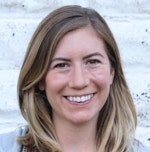When it came time for creative agency Deutsch, Inc. to outfit a full-service production studio for its growing Steelhead Productions division, they called upon HLW International’s Los Angeles studio to reimagine nearly 48,000 square feet of a previously underutilized industrial building located across the street from Deutsch’s existing office.
► Mindful Design & Taking Risks
HLW, with input and collaboration from the Deutsch and Steelhead Productions group, transformed the existing warehouse into versatile office and technical spaces, including three new mezzanines connected by a series of bridges. The overall look and feel of the space combine artistic and cultural elements.
“One of the things that Deutsch really prides themselves on is telling other people’s stories with their advertising and that echoes our brand. I think that’s why we created a great partnership [with Deutsch] because our ethos is ‘Our work tells your story,’” says Stephanie Baca, design director and senior associate at HLW.
Features for a Rennovated Warehouse
The multi-year project unfolded in three phases: structural upgrades to the base building, installation of the new mezzanines and, finally, the interior build out and design. The result was a multi-functional, flexible space that can be modified regularly to meet the needs of the client.
“Fifty percent of all the work stations can be reconfigured. And even the layout that we did is very dynamic and different so it’s not just row upon row of workstations,” says Joseph Bryant, project architect at HLW. He adds, “So again they can really break these areas down and have them work for different groups and different productions.”
The adaptive reuse project included a full rehabilitation of an existing structure and the addition of a new second floor with offices, a post-production house and a full capability shooting stage. The completed space also includes reception, conference and meeting rooms, community areas, a sky garden, a speakeasy, a café and pantry, broadcast studio and other types of broadcast functions.
“They wanted the space to really be a real makerspace, and when visitors or staff are in the space they think, ‘Wow, stuff really gets done here, it’s like a creative workshop.’ Everything’s authentic,” Baca says.
The concept of adaptive reuse – or changing the use and function of an existing building through interventions – is a growing trend as more and more people seek to maintain original character and authenticity, which isn’t always inherently present in new buildings.
“It’s definitely a trend, it’s definitely something people want, they like the older buildings, they like the character that they bring and you’re able to create these new spaces in these older spaces,” Bryant notes.
While HLW frequently takes on these types of renovations, and converts industrial buildings into commercial or office spaces, Baca says this project was unique to Deutsch. “The way that we design is for our clients. We don’t really have a signature style, so it’s about understanding the client, their culture, their goals for the project up front and road-mapping out what does that mean functionally, what does that mean aesthetically, what does that mean culturally and just weaving that story into each of the spaces so that it really echoes who’s in there.”
Turning Challenges into Opportunity
Renovating any existing or aging structure to meet the needs of today’s workspaces comes with challenges. Add in the immensity and variety of activities required of the space and this project provided its own unique challenges.
“I wouldn’t say there were problems, but there were definitely challenges,” Bryant says. “I think it’s always about how you turn a potential problem into an opportunity, and just how do we think about this and what is it going to do for us.”
One unique challenge HLW had to contend with was the building’s location. The entire neighborhood is in a methane zone, with the building itself classified as a level five, the highest level. As Baca puts it, “It sits in a pocket of methane.”
To manage this challenge, HLW used prefabricated mezzanines that were bolted into the ground, as opposed to digging new foundations. Special consideration was also paid to the HVAC system, complicated by a roof that was not equipped to handle the load needed to mitigate the methane issue.
“That load on the roof was intense… We literally had to map out where every single HVAC that was on the roof from the get-go and I believe there is something like 40 of them, which is a lot,” Bryant explains. “We mapped them out and then structurally reinforced that part of the roof to try to avoid rebuilding the entire roof and really be strategic about how we spent the money for that.”
I Hear Design: The interiors+sources PodcastHLW embraced sustainable solutions, and in addition to meeting California’s stringent building codes, Baca says they were intentional in their product choice, frequently using and incorporating recycled or recyclable materials and Forest Stewardship Council-certified woods
“Most of the woods we used on the project were either recycled from within the project, of the demolition, or old reclaimed barnwood,” Baca notes. “It’s really important to us, as stewards of the environment, in our profession to always consider that. We wouldn’t use anything that’s harmful.”
In addition to health and safety considerations, they looked for unique ways to marry the function, utility and aesthetics of the building. For example, one goal was to keep the interior space as free from ductwork and infrastructure as possible, and they achieved this by running much of it along the roof and down the perimeter walls.
Another goal was to provide two entrances with controlled access that would not interfere with typical day-to-day activities while still allowing renters to access a 10,000-square-foot studio that Deutsch intends to lease out to other production companies. In working with Deutsch and incorporating many of their thoughts, ideas and even artwork, they were able to come up with a variety of solutions to meet any challenge.
“For us, I think it was a really fun project because you don’t get clients that like to think outside the box as much… but for this project we had so many iterations of design until we found the sweet spot,” Baca says.





